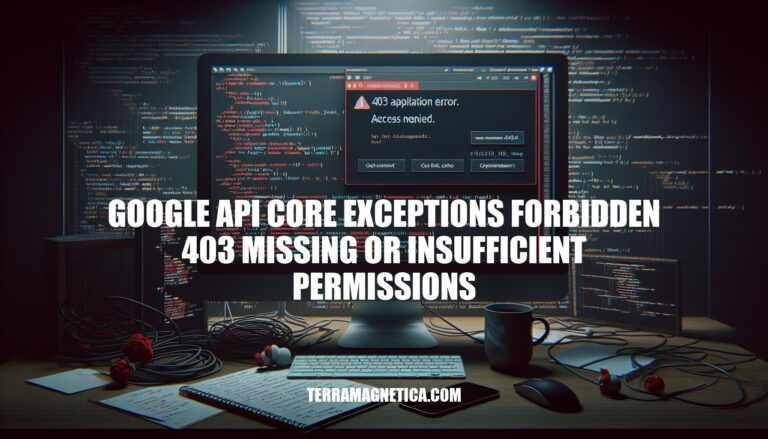The “Google API core exceptions forbidden 403: missing or insufficient permissions” error occurs when a user or application tries to access a Google API without the necessary permissions. This error is significant because it prevents unauthorized access to sensitive data and resources.
Common scenarios where this error occurs include:
- Incorrect API Key or OAuth Token: The credentials provided do not have the required permissions.
- Disabled API: The specific API being accessed is not enabled in the Google Cloud project.
- Insufficient Permissions: The user or service account lacks the necessary permissions to perform the requested action.
Would you like to know how to resolve this error?
Causes
Here are the primary causes of the “google api core exceptions forbidden 403 missing or insufficient permissions” error:
- Incorrect API Key Usage: Using an invalid or incorrect API key can trigger this error.
- Lack of Required Permissions: The user or service account does not have the necessary permissions to access the requested resource.
- Disabled API Services: The specific API service being called is not enabled in the Google Cloud project.
- Scope Issues: The OAuth token does not include the required scopes for the API request.
- Permission Propagation: Permissions on a shared resource might not be properly propagated.
Symptoms
The ‘google api core exceptions forbidden 403 missing or insufficient permissions’ error typically manifests with the following symptoms and error messages across different Google APIs:
-
Google Drive API:
- Error Message:
403 Forbidden: The request was received and understood, but the user doesn't have permission to perform the request.
- Symptom: Occurs when a user tries to access or modify a file without the necessary permissions.
-
Google Cloud Datastore API:
- Error Message:
403 PERMISSION_DENIED: Missing or insufficient permissions.
- Symptom: Appears when a user attempts to run a query or access data without the required permissions.
-
Google BigQuery API:
- Error Message:
403 Access Denied: Missing or insufficient permissions.
- Symptom: Happens when a user tries to access datasets or tables without proper authorization.
-
Google Document AI API:
- Error Message:
403 Forbidden: POST Document AI API has not been used in project # before or it is disabled.
- Symptom: Occurs when the API is not enabled for the project or the user lacks the necessary permissions.
These errors generally indicate that the user does not have the appropriate permissions to perform the requested action.
Troubleshooting Steps
Here are the steps to troubleshoot and resolve the ‘google api core exceptions forbidden 403 missing or insufficient permissions’ error:
-
Check API Key Permissions:
- Ensure the API key has the necessary permissions for the specific API you’re trying to access.
- Verify that the API key is correctly configured in the Google Cloud Console.
-
Enable Necessary APIs:
- Go to the Google Cloud Console.
- Navigate to the API & Services section.
- Ensure the required APIs are enabled for your project.
-
Verify User Roles:
- Check the IAM (Identity and Access Management) roles assigned to the user or service account.
- Ensure the user or service account has the necessary roles and permissions to access the API.
-
Check Quotas and Limits:
- Verify that your project has not exceeded its quota limits for the API.
- Adjust quotas if necessary in the Google Cloud Console.
-
Review API Documentation:
- Refer to the specific API documentation for any additional requirements or configurations needed.
-
Check for API Restrictions:
- Ensure there are no IP address restrictions or other security settings that might be blocking access.
-
Retry After Enabling APIs:
- If you recently enabled an API, wait a few minutes for the changes to propagate and then retry the request.
Following these steps should help you resolve the error.
Best Practices
- Regular Permission Audits: Periodically review and update permissions to ensure only authorized users have access.
- Proper API Key Management: Secure API keys, rotate them regularly, and restrict their usage to specific IP addresses or referrer URLs.
- Use Service Accounts: Employ service accounts for server-to-server interactions, ensuring they have the necessary roles and permissions.
- Scope Management: Assign the minimum required scopes to applications to limit access.
- Error Monitoring: Implement logging and monitoring to quickly identify and resolve permission issues.
- Role-Based Access Control (RBAC): Use RBAC to manage user permissions efficiently.
- OAuth 2.0: Use OAuth 2.0 for secure and scalable authorization.
These practices help maintain security and prevent the ‘403 Forbidden’ error.
The ‘Google API core exceptions forbidden 403: missing or insufficient permissions’ error
occurs when users or applications lack necessary permissions to access Google APIs.
Common causes include:
- Incorrect API keys
- Disabled APIs
- Insufficient user permissions
To resolve this error, check API key permissions, enable necessary APIs, verify user roles, review quotas and limits, and refer to API documentation.
Regular permission audits, proper API key management, using service accounts, scope management, error monitoring, role-based access control (RBAC), and OAuth 2.0 are essential practices for maintaining security and preventing this error.


